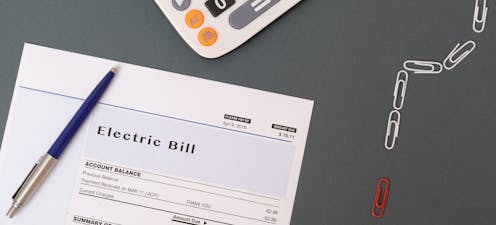If you need a PhD to read your power bill, buying wisely is all but impossible
- Written by Bruce Mountain, Director, Victoria Energy Policy Centre, Victoria University

A recent survey found that Australia’s power companies are less trusted than media companies, banks and telcos. Customers hate electricity bills – not least because they are so complicated. But we can learn much by analysing them closely.
One feature that deserves close scrutiny is the all-pervasive discount. In electricity retailing, all but 3 of the 28 active retailers use discounts in their retail offers.
In any kind of retailing, discounts give customers the impression that they are making a smart buy. This is often true, particularly in cases where it is easy to see and compare the discounted prices. But if it’s not easy to compare, customers may not realise if they’ve been duped.
Read more: Australian household electricity prices may be 25% higher than official reports
With electricity bills, it is all but impossible for customers to know whether their discounted price really represents a good deal. This is because the discounts are ludicrously complicated – as are the base prices themselves.
Large businesses do not complain about retail electricity markets. This is because they have the capacity, either in-house or through consultants, to evaluate complex retail price structures. Advances in data science may yet make such expertise available to everyone.
Eye-wateringly complex
To fairly compare your bill, you must be able to adjust for the discount in your current bill, and also in all the alternative competing offers. Having worked with thousands of bills, I know the myriad ways discounts are calculated make this terribly difficult.
Read more: A high price for policy failure: the ten-year story of spiralling electricity bills
Let us count the ways a discount may be applied:
some discounts are worked out as a percentage of usage charges while others are on the total bill
some discounts are before the receipt of concessions, others after
some discounts are before solar feed-in receipts, others after
few bills actually clearly state the discount rate, and some don’t state the rate at all
some discounts are only received on subsequent bills (so that if the customer leaves, the retailer avoids discounting their last bill)
some retailers offer several discounts in the bill but sometimes some apply after other discounts are taken off first
some will discount controlled load consumption, others not
some discounts are payable as rebates when the customer transfers to the retailer; other rebates are paid out over months and even years
some offer discounted amounts which are contingent on advance purchases of electricity, but the discount is not achieved unless purchases exceed the contingent amounts
some discounts in bills are not actually calculated in customers’ bills as the retailers say they are calculated
some retailers take up-front payments from customers and then feed those payments back to customers on each subsequent bill as if they are discounts
most discounts are conditional on customers doing something (usually paying the bill on time) but some are unconditional. Some bills have both conditional and unconditional discounts; others just one or the other.
Read more: You're paying too much for electricity, but here's what the states can do about it
If that isn’t enough, electricity tariffs in Australia are stunningly complex commercial arrangements. They have daily charges and a wide range of methods for charging for consumption: flat rates; daily, monthly or quarterly block rates; time-of-use rates with two or three bands; combinations of time-of-use and block rates; one or more separate rates for controlled loads of different types; consumption rates that are seasonal; and now some bills with peak demand charges.
Solar feed-in rates offered by retailers often (but not always) vary depending on the receipt of subsidies. Most recently, some retailers have offered block rates for solar feed-in, or different prices for the first tranche of solar power feed-in.
What can you do?
It is no surprise that few customers have the time or skill needed to choose wisely. While this is not a peculiarly Australian phenomenon – evidence from abroad shows that lots of money is left on the table even when customers try to buy well – we think it is worse here. Our research is working to quantify this in Australia.
Government price comparison sites, like Energy Made Easy, are often advanced as solutions. But a 2017 competition review found that these have had limited success in Australia and elsewhere.
Complexity trips up governments too, and retailers work hard to persuade the regulators and policy makers to their point of view.
Regulating complexity away through standardisation is also suggested. Tight regulation can work well; think of the excellent market for bread and patisserie in France. But standardising the sale of electricity often comes at the expense of incentives for retailers to discover customers’ needs, and may increase rather than reduce average prices.
Policymakers want both customer protection and incentives to innovation. But the desire to have one’s cake and eat it can lead to half-baked solutions that make matters worse.
The solution may be to master the complexity rather than trying to regulate it away. Many existing price comparison websites offer limited coverage of the market of competing offers, or look at only the energy consumption portion of a customer’s existing bill.
However advances in data science now make it cost effective to provide small customers with on-going analysis of their usage and their retailer’s charges in order to ensure that they are always on the best deal for them. Businesses using this approach overseas are well established, and the scope for further innovation is very large.
Overcoming the complexity of the retail market will take away the wool that retailers have a powerful incentive to pull over their customers’ eyes.
Authors: Bruce Mountain, Director, Victoria Energy Policy Centre, Victoria University





